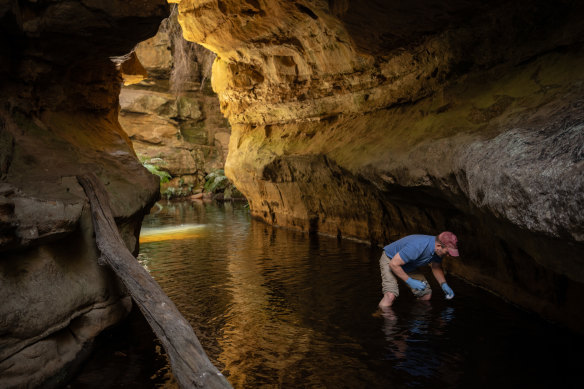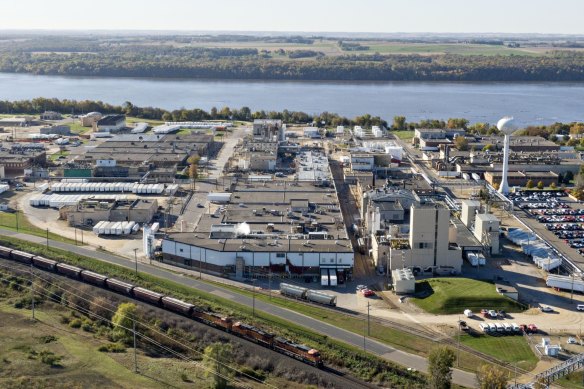Australia’s safe limits for cancer-linked “forever chemicals” in drinking water will be dramatically lowered under a proposal that is likely to force the clean-up of tap water supplied to hundreds of thousands of people across the country.
The new thresholds, to be announced by the National Health and Medical Research Council on Monday, would slash allowable levels of three different kinds of per- and polyfluoroalkyl chemicals (PFAS) in tap water and introduce limits for the first time on a fourth.

Water scientist Ian Wright takes a water sample near Lake Medlow in the Blue Mountains.Credit: Wolter Peeters
The changes come after the United States, which is ground zero for the global pollution disaster that has contaminated the blood of the entire Australian population, introduced the world’s most stringent drinking water standards in April.
Australia’s proposed limits mirror the tough new US standards for one of the chemicals, go even further for another, and for two of the chemicals are significantly more lenient.
Under the changes, Australia would allow the carcinogenic forever chemical perfluorooctanoic acid (PFOA) in drinking water at 50 times the level the US will allow.
The overhaul of Australia’s drinking water standards come after an investigation by this masthead laid bare the staggering extent to which the man-made chemicals have infiltrated drinking water supplies across the country.

A 3M PFAS plant in Cottage Grove, Minnesota. It was one of the main manufacturing plants for forever chemicals that have contaminated the world.Credit: Bloomberg
According to the limited publicly available data compiled by this masthead, PFAS have previously been discovered in drinking water supplies at levels which would breach the proposed new guidelines in up to a dozen locations across Australia since 2010.
The US has warned there is no safe level of the chemicals, which have been detected at trace levels in the water of up to 1.8 million Australians over the same time frame.
The true extent of the problem remains unknown. Many drinking water supplies across the country have never been sampled for PFAS because it has not been required by state and territory health regulators.
This masthead’s reporting forced authorities to undertake routine monitoring of Sydney’s drinking water supply for the first time and resulted in the closure of two dams in the Blue Mountains where elevated levels were discovered.
The family of chemicals, famous for their extraordinary ability to repel stains and water, have been linked to a slew of adverse health effects including cancer, suppression of the immune system, high cholesterol and thyroid disease.
NSW locations that have recorded recent detections breaching the proposed new standards include the Cascade water filtration plant supplying tens of thousands of people in the upper Blue Mountains, and Grahamstown Dam, which supplies up to 400,000 people across the Newcastle region.
Sources told this masthead that under the proposed changes, Australia’s allowable level of perfluorooctane sulfonate (PFOS) in drinking water would plunge to four nanograms per litre, in line with the US limit.
The chemical was formerly the key ingredient in 3M’s popular fabric protector, Scotchgard, and was also used widely in food packaging and firefighting foam until the company phased it out of production in the early 2000s.
Industry has rolled out a new type of forever chemical to replace PFOS, called perfluorobutane sulfonate (PFBS).
Australia has proposed a world-leading limit of 1000 nanograms per litre for PFBS, which is half the amount that US drinking water guidelines recommend.
PFBS is used to manufacture non-stick consumer products, and has been linked to reproductive and developmental effects, and thyroid and kidney changes in laboratory animals.
Australia’s allowable level of perfluorooctanoic acid (PFOA), also known as the Teflon chemical, would be reduced from 560 nanograms per litre to 200 nanograms per litre.
Australia’s limit would still be 50 times higher than America’s maximum limit of four nanograms per litre for the chemical, which was recently declared carcinogenic by the World Health Organisation.
Australia has also proposed a limit for the forever chemical perfluorohexanesulfonic acid (PFHxS) of 30 nanograms per litre, which is three times higher than the US standard of 10 nanograms per litre.
The draft guidelines will be subject to public consultation before they are finalised.
The developments are likely to raise questions about whether Australian taxpayers should have to shoulder the expense of cleaning up a contamination problem which has largely been sheeted home to the actions of two American corporate giants, 3M Company and DuPont.
3M recently agreed to pay $US10.3 billion ($15.3 billion) to bankroll the clean-up of water supplies across the US after it settled a lawsuit in which it was accused of knowing about the risks of its forever chemicals for decades but failed to warn users, bystanders or public agencies, while it raked in billions in profit.
The Australian government has already flagged the possibility of legal action against 3M after paying nearly $400 million to compensate communities near defence bases contaminated with firefighting foam containing forever chemicals.
Get to the heart of what’s happening with climate change and the environment. Sign up for our fortnightly Environment newsletter.
correction
An earlier version of this article said that the discovery of elevated levels of PFAS forced the closure of a dam in the Blue Mountains. The discovery forced the closure of two dams, Medlow Dam and Greaves Creek Dam.